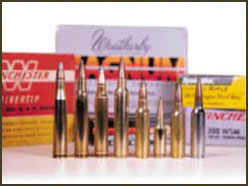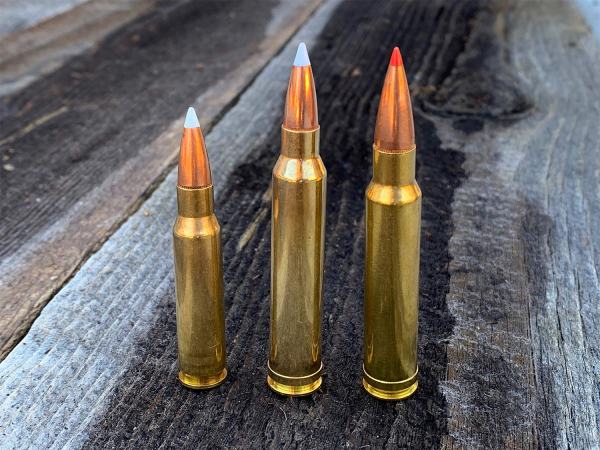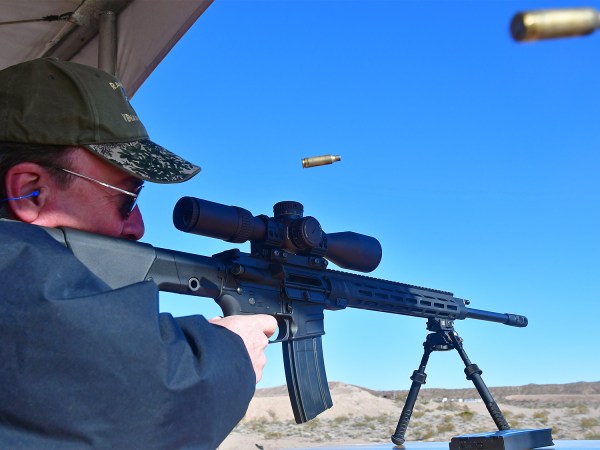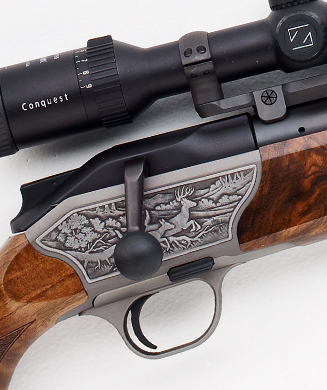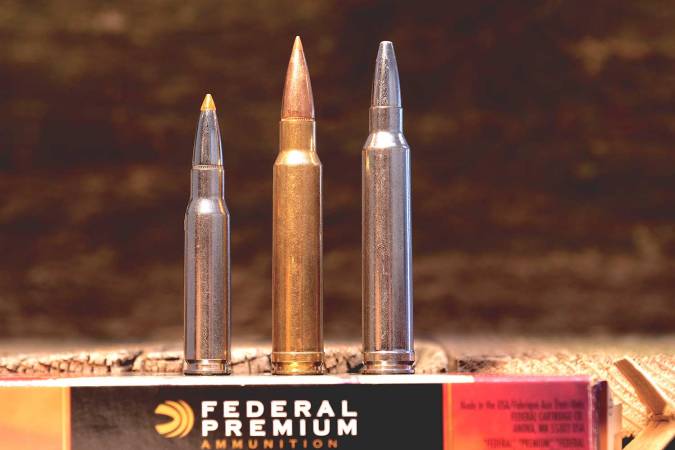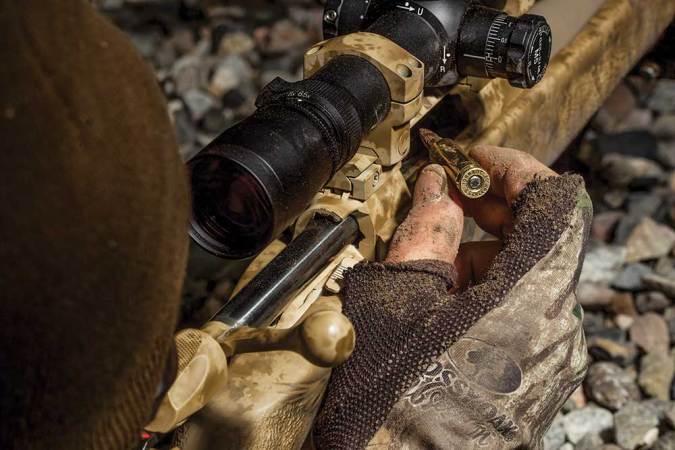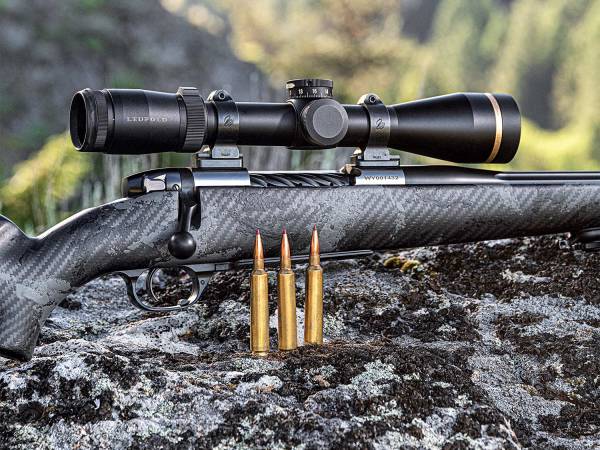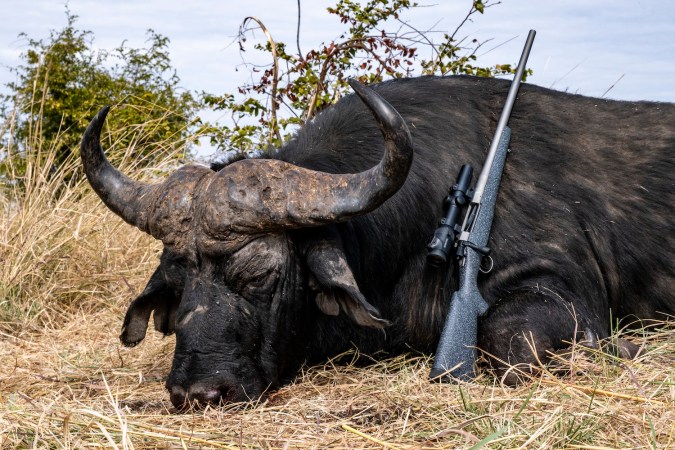We may earn revenue from the products available on this page and participate in affiliate programs. Learn More ›
The most discussed cartridge of recent timesis the .300 WSM (Winchester Short Magnum). Months before it showed up on dealers’ shelves, Internet gun forums and gun-shop gossip sessions were abuzz with speculation about the new round. And the few available samples were gazed upon with the respectful awe one usually reserves for sacred icons or fine art.
The reason for all the excitement? Winchester’s .300 WSM packs the power of the gunmaker’s popular .300 Magnum into a cartridge case no longer than the stubby little .308 Win. And in case you haven’t heard, Remington also has just introduced two stubbies of its own: a 7mm Ultra SA (Short Action), which duplicates the performance of its best-selling 7mm Rem. Mag., and a .300 Ultra SA, which, like the WSM, matches the ballistics of the bigger .300 Win. Mag.
The advantage of these new short-magnum cartridges is that they can be combined with light, quick-handling, carbine-size rifles whose actions are shorter and lighter than those necessary for the longer magnum-class rounds. But from where I sit, the introduction of these new short rounds is of far greater and more lasting importance. In fact, had it been my choice, I would have left the word “Magnum” out of their names and instead called them something like “New Era” or “CCC 21” “Cartridge Concept Century 21” because they are indeed benchmark developments that raise the curtain on cartridge design for the coming century. [pagebreak]
The Magnum Chronicles
Before getting too deep into the rationale behind the Short Mag concept, let’s take a look at the family tree of the magnum clan. This will help us better understand the roots of modern ballistic thinking and what has happened to make ballistic development suddenly veer off in an unexpected direction. Perched on the first branch of the magnum family tree is the .300 H&H; Mag., born back in 1925. Sure, there were plenty of “magnums” before that, including the .375 H&H;, which sired the .300. In fact, the somewhat vague appellation has been around ever since someone had the brainstorm of comparing jumbo-size cartridges to oversized magnum bottles of wine (probably a gun writer in need of a phrase to turn). What made Holland & Holland’s .300 different from other magnums of that era was that it propelled a bullet of otherwise ordinary caliber and weight at higher-than-ordinary velocity.
Looking at the H&H; branch of the magnum family tree you see offspring dangling like Christmas ornaments, with the Weatherby cartridges glittering brightest of all. Roy Weatherby, a ceaseless experimenter who promoted his products with the persistence of a foghorn, raised the bar on hunting cartridges by the simple act of puffing out the shoulder of the aging .300 H&H; so it would hold even more propellant. His first effort, the .270 Weatherby Magnum, bested the .270 Winchester’s muzzle speed with a 130-grain bullet by well over 200 feet per second (fps). In short order, other Weatherby “Magnums,” including the .300, 7mm, .257 and .375, outpaced their staid counterparts by similar numbers.
It was Weatherby, more so than all other gunmakers combined, who hammered the word magnum into the minds of hunters and shooters worldwide. And it was he who adopted the H&H; belted case as his symbol and affixed it to every Weatherby cartridge design. Ironically, though, the “belt” at the base of the magnum case (a necessary headspacing feature on the shallow-shouldered H&H; cartridges) was unneeded on the Weatherbys. However, they added a distinctive and robust profile to any magnum cartridge. (Remember this belt, because as we shall see, it was to become a major point of departure some years later.) In time, as the Weatherby line expanded and gained mainstream respectability, it formed its own separate branch of the magnum family tree. As it did so yet another magnum was sprouting — the standard magnum.
A basic problem with buildg rifles for the .300 H&H; and its myriad offspring was the steeple-like length of the cases. Gunmakers had to build special rifle actions (as Weatherby eventually did) or extensively modify them to allow them to hold and function with larger-than-standard-size cartridges like the .30/06. “Why not simply shorten the belted magnum case to standard length,” someone decided, “so it would adapt to the popular standard-length actions?” And so it came to pass that the mountain came to Muhammad, so to speak, and the standard magnums, like the 7mm Remington and .300 Winchester magnums, all sporting the distinctive belt, became the most popular and best-selling branch of the magnum tree. Of all the standard magnum cartridges, only the .458 Mag. has a legitimate use for a belted case, but in the hearts and souls of many, “If it ain’t got a belt, it ain’t a magnum.” [pagebreak]
Rebirth of the .404
Even so, as the 20th century ambled toward its close, the belted case became the focus of critical review. Not only was the belt unnecessary on most “magnum” cartridges, but it might actually be a hindrance to accuracy. Besides that, the belt sometimes caused feeding problems and was wasting space in the magazine. “Why not simply make the whole case body as big around as the belt?” came the suggestion from several directions. “That way the powder capacity will be increased and performance will improve accordingly.”
In the oft-excavated fields of cartridge design it is rare indeed for a new cartridge to be fashioned whole cloth of new and unique dimensions. Instead, existing cases are shortened, lengthened, necked up or down, squeezed in or puffed out in accordance with the whims of the designer. (The old .300 H&H; case is the classic example.) So the search this time was for a case as fat all around as the belt and rim of the old H&H.; And guess what. The winner was a nearly forgotten British cartridge euphoniously titled the .404 Jeffery Nitro Express. With a base diameter of .544 inches, it was nearly perfect — not too big to function in standard rifles, yet offering considerably increased powder capacity over the old belted case.
One of the first experimenters to grab the .404 Jeffery case and run with it was Don Allen, founder of Dakota Arms. With the .404 case shortened to “standard” magnum length (2.500 inches, give or take a few thousandths), his 7mm Dakota topped the velocity of the 7mm Remington Magnum by 225 fps (3,400 fps with a 140-grain bullet). His .300 and .338 Dakotas bested their belted brethren by similar numbers. Cartridge designers and wildcatters being who they are, it wasn’t long before everyone “discovered” the .404 Jeffery case.
While all this discovering was taking place, another group of fanatical experimenters was on an entirely different trail. These were the benchrest shooters and other assorted seekers of accuracy. According to classical ballistics, a cartridge case does nothing but hold the propellant, and its shape is unrelated to accuracy per se. But that thinking went back to blackpowder days, and by the 1970s a growing number of benchrest shooters were convinced that case shape was a factor in accuracy. Their proof came in the form of a fat and stubby little case design that was made by puffing out the shoulders of a once remote cartridge known as the .220 Russian. The details of this conversion had been refined by bench-shooters Ferris Pindell and Lou Palmisano, so the result of their efforts became known as the .22 PPC and 6mm PPC. During the 1980s and ’90s, the 6PPC became the most successful benchrest round to date and there were few who doubted that its pudgy figure had a lot to do with its inherent accuracy. But by no means was the 6PPC a magnum. In fact, quite the opposite was true, as its creators had something else in mind entirely. But unbeknownst to all, two widely separated byways — magnum performance and extreme accuracy — were beginning to curve toward one another.
The last hurrah of the 20th century, magnumwise, was Remington’s grandiose .300 Ultra Mag., for which the gunmaker pulled out all the stops. Combining the length of the old .300 H&H; with the beer-belly powder capacity of a big beltless case, the Rem. Ultra sends a 180-grain bullet on its way at 3,250 fps and achieves Remington’s goal of surpassing, or at least equaling, the .300 Weatherby. Meanwhile Weatherby had topped its own ballistics with the outsize .30/378. By now, these figures are well known, as are the ballistics of the subsequent 7mm, .338 and .375 Rem. Ultra Mag. There is a saying that an empire is mightiest just before it crumbles, and firearms history may record these final giants as prophets of their own Gotterdammerung. For finally, those two byways, once so far apart, were converging into a hitherto untraveled turnpike: the short magnum. [pagebreak]
Short-Mag Revolution
Most of what we’re reading and hearing about these radical new cartridges is that they pack a lot of power into lightweight rifles. That alone is justification for their existence, as noted earlier. That they will succeed there is little doubt, but ultimately they will succeed for reasons much removed from their portability. This prediction demands some explanation: First of all, the focus of cartridge performance in recent times has been largely concentrated on accuracy. One big reason for this is the increasing interest in taking game at greater shooting distances. Even hunters who renounce others who pursue the 500-yard — or longer — “trophy shot” are increasingly enamored of rifles and calibers that deliver bullets precisely where they are aimed. After all, it just makes good sense.
From the standpoint of design, one of the building blocks of accuracy is short, stiff actions. Does that ring a bell? And from the benchrest clan we’ve learned that plump-and-stumpy cartridge cases tend to deliver better accuracy. Does that ring another bell? If not, compare the new short magnums with the PPC or 6mm Remington BR, another paragon of accuracy. The similarity is striking, with the short mags being little more than scaled-up versions of these petite darlings of accuracy.
When you fit these connections together, the temptation is to slap your forehead and say, “Wow, that’s so obvious, why wasn’t it done long before now?” Good question, but as you’ve already seen, cartridge development progresses along a linear trajectory and a mere generation ago there didn’t exist the propellants to make the short magnum idea a viable concept. And we didn’t have the ballistically superior bullets that are necessary to make long-range accuracy a realistic proposition.
Currently, gunmakers Browning and Winchester are concentrating on making lightweight hunting rifles in .300 WSM. Meanwhi- were beginning to curve toward one another.
The last hurrah of the 20th century, magnumwise, was Remington’s grandiose .300 Ultra Mag., for which the gunmaker pulled out all the stops. Combining the length of the old .300 H&H; with the beer-belly powder capacity of a big beltless case, the Rem. Ultra sends a 180-grain bullet on its way at 3,250 fps and achieves Remington’s goal of surpassing, or at least equaling, the .300 Weatherby. Meanwhile Weatherby had topped its own ballistics with the outsize .30/378. By now, these figures are well known, as are the ballistics of the subsequent 7mm, .338 and .375 Rem. Ultra Mag. There is a saying that an empire is mightiest just before it crumbles, and firearms history may record these final giants as prophets of their own Gotterdammerung. For finally, those two byways, once so far apart, were converging into a hitherto untraveled turnpike: the short magnum. [pagebreak]
Short-Mag Revolution
Most of what we’re reading and hearing about these radical new cartridges is that they pack a lot of power into lightweight rifles. That alone is justification for their existence, as noted earlier. That they will succeed there is little doubt, but ultimately they will succeed for reasons much removed from their portability. This prediction demands some explanation: First of all, the focus of cartridge performance in recent times has been largely concentrated on accuracy. One big reason for this is the increasing interest in taking game at greater shooting distances. Even hunters who renounce others who pursue the 500-yard — or longer — “trophy shot” are increasingly enamored of rifles and calibers that deliver bullets precisely where they are aimed. After all, it just makes good sense.
From the standpoint of design, one of the building blocks of accuracy is short, stiff actions. Does that ring a bell? And from the benchrest clan we’ve learned that plump-and-stumpy cartridge cases tend to deliver better accuracy. Does that ring another bell? If not, compare the new short magnums with the PPC or 6mm Remington BR, another paragon of accuracy. The similarity is striking, with the short mags being little more than scaled-up versions of these petite darlings of accuracy.
When you fit these connections together, the temptation is to slap your forehead and say, “Wow, that’s so obvious, why wasn’t it done long before now?” Good question, but as you’ve already seen, cartridge development progresses along a linear trajectory and a mere generation ago there didn’t exist the propellants to make the short magnum idea a viable concept. And we didn’t have the ballistically superior bullets that are necessary to make long-range accuracy a realistic proposition.
Currently, gunmakers Browning and Winchester are concentrating on making lightweight hunting rifles in .300 WSM. Meanwhi
